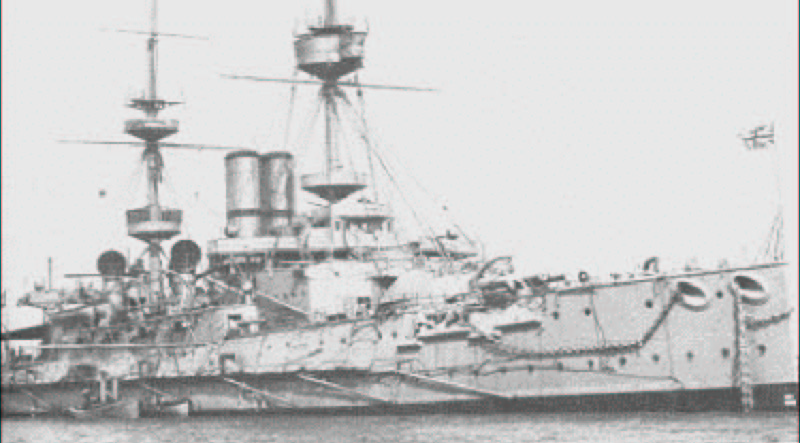Torpedo Nets
By Bill Russell
During the 1870’s,
the world’s navies began to experiment with torpedoes that we would
recognize as precursors of today’s weapons of the same name. By
1885, the British navy included torpedo boats that could launch
torpedoes capable of 30 knots and a range of 7,000 yards carrying a
warhead containing 200 pounds of explosives.
The leading naval powers recognized the torpedo as a major threat to
their fleets of expensive battleships in the late 1870’s. They
approached the problem from two directions. First, various changes
were made to the hull design to mitigate the effects of under-water
explosions, and by the 1880’s, several navies, including those of
the British, Japanese, Russians, and French began to employ
anti-torpedo nets. For some reason, I have found no evidence that
the US Navy used the torpedo nets.
 The idea of the torpedo net was to suspend a heavy metal net about
30 feet from the hull to “catch” the in-coming torpedoes. The nets
were made of steel rings about 2.5 inches in diameter that were
assembled as a continuous barrier similar to the chain mail worn by
medieval knights. The torpedo nets were hung from the water level
down to the level of the keel (Ref. 4) or about ¾ the distance from
the water level to the keel (Ref. 1). In some respects, they were
handled like sails, and when not deployed (See photo above), were
brailed, furled, and laid on a surface provided for the purpose.
Torpedo nets can be an interesting feature on a model of an early
warship.
The idea of the torpedo net was to suspend a heavy metal net about
30 feet from the hull to “catch” the in-coming torpedoes. The nets
were made of steel rings about 2.5 inches in diameter that were
assembled as a continuous barrier similar to the chain mail worn by
medieval knights. The torpedo nets were hung from the water level
down to the level of the keel (Ref. 4) or about ¾ the distance from
the water level to the keel (Ref. 1). In some respects, they were
handled like sails, and when not deployed (See photo above), were
brailed, furled, and laid on a surface provided for the purpose.
Torpedo nets can be an interesting feature on a model of an early
warship.
Unfortunately, the torpedo nets did not achieve their intended
purpose, especially when the ship was moving. The situation was
slowly recognized, and some of the last battleships to be built with
them were in the Fuso class of Japan in 1914. Existing battleships
continued to employ them later. The final blow came when the
pre-Dreadnought Majestic was sunk by a torpedo in 1915 during the
Gallipoli campaign. She was stationary, with nets deployed when a
torpedo equipped with wire cutters sliced through the nets and sank
the ship. By 1916, the torpedo nets were no longer used though
isolated examples can be found later. (Tradition I suppose.)
References:
1. British Battleships of World War I, by R. A. Burt, 1986, USNI
Press.
2. British Battleships from 1886 to 1904, by R. A. Burt, 1988, USNI
Press.
3. HMS Dreadnought (Anatomy of the Ship), by John Roberts, 1992,
USNI Press.
4. The Complete Encyclopedia of Battleships, by Tony Gibbons, 1983,
Crescent Books. The idea of the torpedo net was to suspend a heavy metal net about
30 feet from the hull to “catch” the in-coming torpedoes. The nets
were made of steel rings about 2.5 inches in diameter that were
assembled as a continuous barrier similar to the chain mail worn by
medieval knights. The torpedo nets were hung from the water level
down to the level of the keel (Ref. 4) or about ¾ the distance from
the water level to the keel (Ref. 1). In some respects, they were
handled like sails, and when not deployed (See photo above), were
brailed, furled, and laid on a surface provided for the purpose.
Torpedo nets can be an interesting feature on a model of an early
warship.
The idea of the torpedo net was to suspend a heavy metal net about
30 feet from the hull to “catch” the in-coming torpedoes. The nets
were made of steel rings about 2.5 inches in diameter that were
assembled as a continuous barrier similar to the chain mail worn by
medieval knights. The torpedo nets were hung from the water level
down to the level of the keel (Ref. 4) or about ¾ the distance from
the water level to the keel (Ref. 1). In some respects, they were
handled like sails, and when not deployed (See photo above), were
brailed, furled, and laid on a surface provided for the purpose.
Torpedo nets can be an interesting feature on a model of an early
warship.